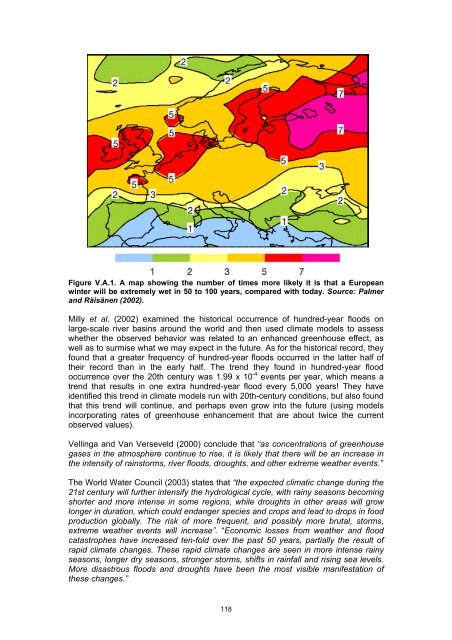Climate Change and the European Water Dimension - Agri ...
Climate Change and the European Water Dimension - Agri ...
Climate Change and the European Water Dimension - Agri ...
You also want an ePaper? Increase the reach of your titles
YUMPU automatically turns print PDFs into web optimized ePapers that Google loves.
Figure V.A.1. A map showing <strong>the</strong> number of times more likely it is that a <strong>European</strong><br />
winter will be extremely wet in 50 to 100 years, compared with today. Source: Palmer<br />
<strong>and</strong> Räisänen (2002).<br />
Milly et al. (2002) examined <strong>the</strong> historical occurrence of hundred-year floods on<br />
large-scale river basins around <strong>the</strong> world <strong>and</strong> <strong>the</strong>n used climate models to assess<br />
whe<strong>the</strong>r <strong>the</strong> observed behavior was related to an enhanced greenhouse effect, as<br />
well as to surmise what we may expect in <strong>the</strong> future. As for <strong>the</strong> historical record, <strong>the</strong>y<br />
found that a greater frequency of hundred-year floods occurred in <strong>the</strong> latter half of<br />
<strong>the</strong>ir record than in <strong>the</strong> early half. The trend <strong>the</strong>y found in hundred-year flood<br />
occurrence over <strong>the</strong> 20th century was 1.99 x 10 -4 events per year, which means a<br />
trend that results in one extra hundred-year flood every 5,000 years! They have<br />
identified this trend in climate models run with 20th-century conditions, but also found<br />
that this trend will continue, <strong>and</strong> perhaps even grow into <strong>the</strong> future (using models<br />
incorporating rates of greenhouse enhancement that are about twice <strong>the</strong> current<br />
observed values).<br />
Vellinga <strong>and</strong> Van Verseveld (2000) conclude that “as concentrations of greenhouse<br />
gases in <strong>the</strong> atmosphere continue to rise, it is likely that <strong>the</strong>re will be an increase in<br />
<strong>the</strong> intensity of rainstorms, river floods, droughts, <strong>and</strong> o<strong>the</strong>r extreme wea<strong>the</strong>r events.”<br />
The World <strong>Water</strong> Council (2003) states that “<strong>the</strong> expected climatic change during <strong>the</strong><br />
21st century will fur<strong>the</strong>r intensify <strong>the</strong> hydrological cycle, with rainy seasons becoming<br />
shorter <strong>and</strong> more intense in some regions, while droughts in o<strong>the</strong>r areas will grow<br />
longer in duration, which could endanger species <strong>and</strong> crops <strong>and</strong> lead to drops in food<br />
production globally. The risk of more frequent, <strong>and</strong> possibly more brutal, storms,<br />
extreme wea<strong>the</strong>r events will increase”. “Economic losses from wea<strong>the</strong>r <strong>and</strong> flood<br />
catastrophes have increased ten-fold over <strong>the</strong> past 50 years, partially <strong>the</strong> result of<br />
rapid climate changes. These rapid climate changes are seen in more intense rainy<br />
seasons, longer dry seasons, stronger storms, shifts in rainfall <strong>and</strong> rising sea levels.<br />
More disastrous floods <strong>and</strong> droughts have been <strong>the</strong> most visible manifestation of<br />
<strong>the</strong>se changes.”<br />
118













